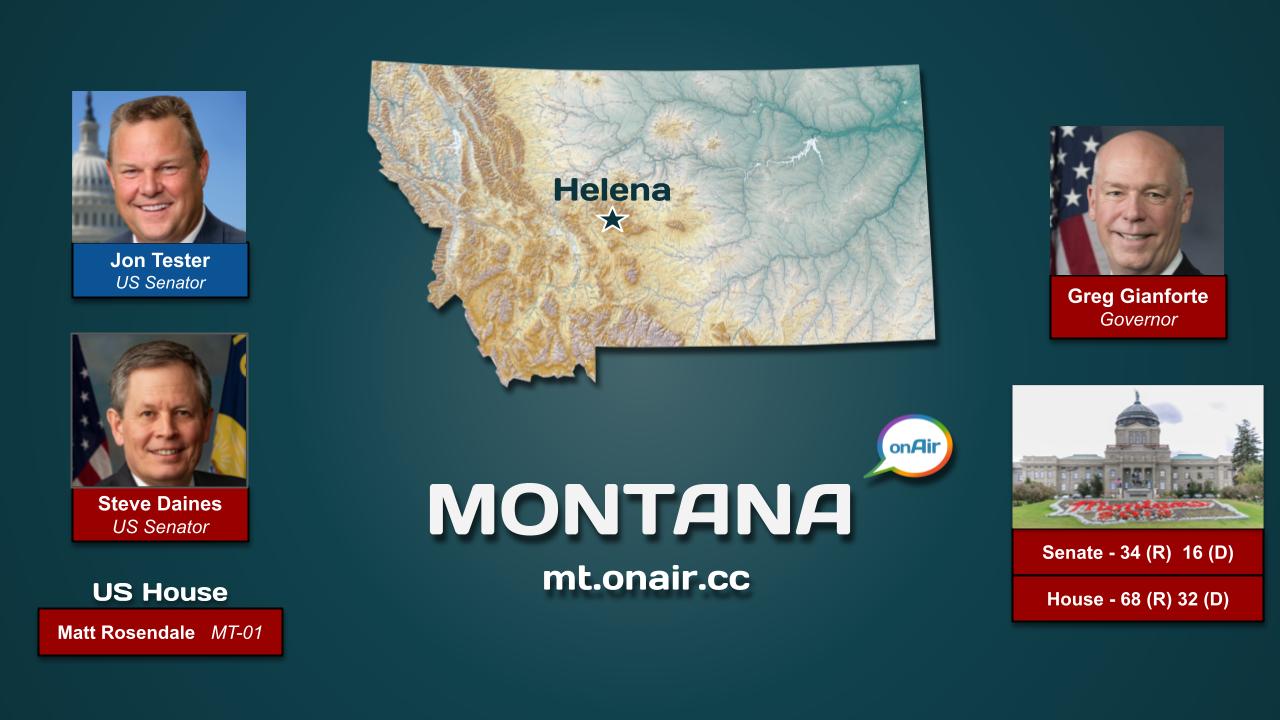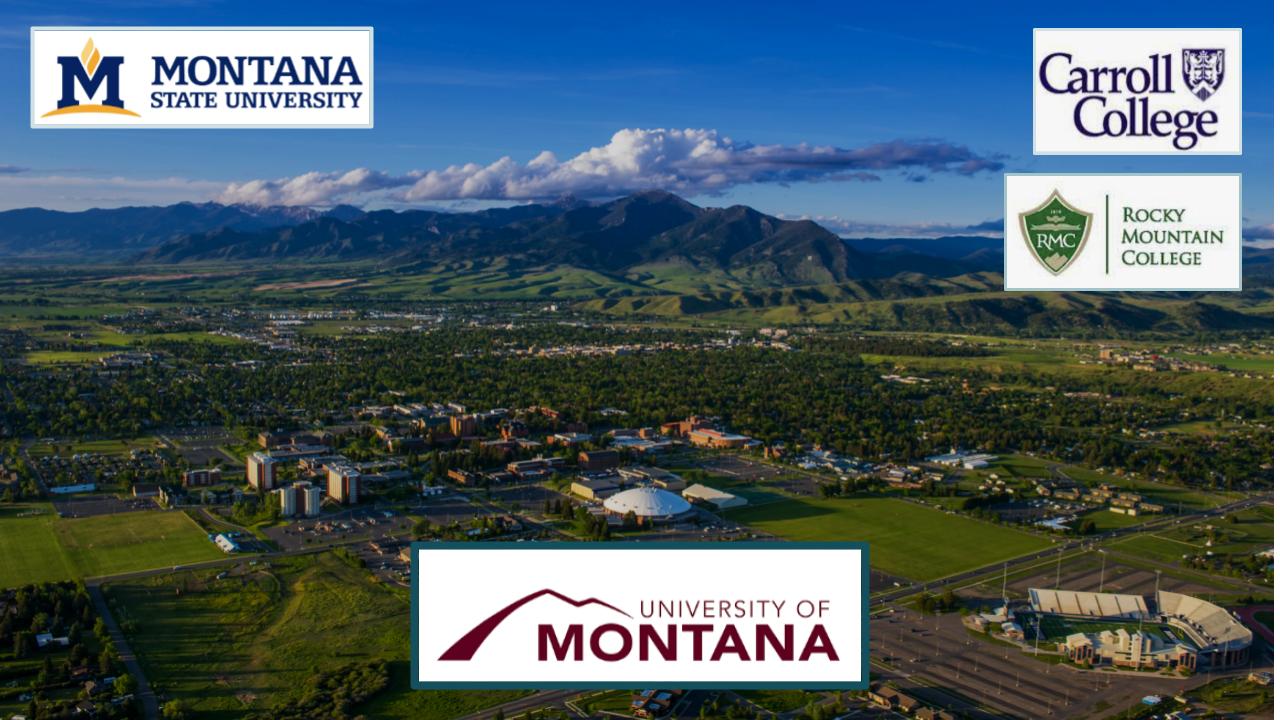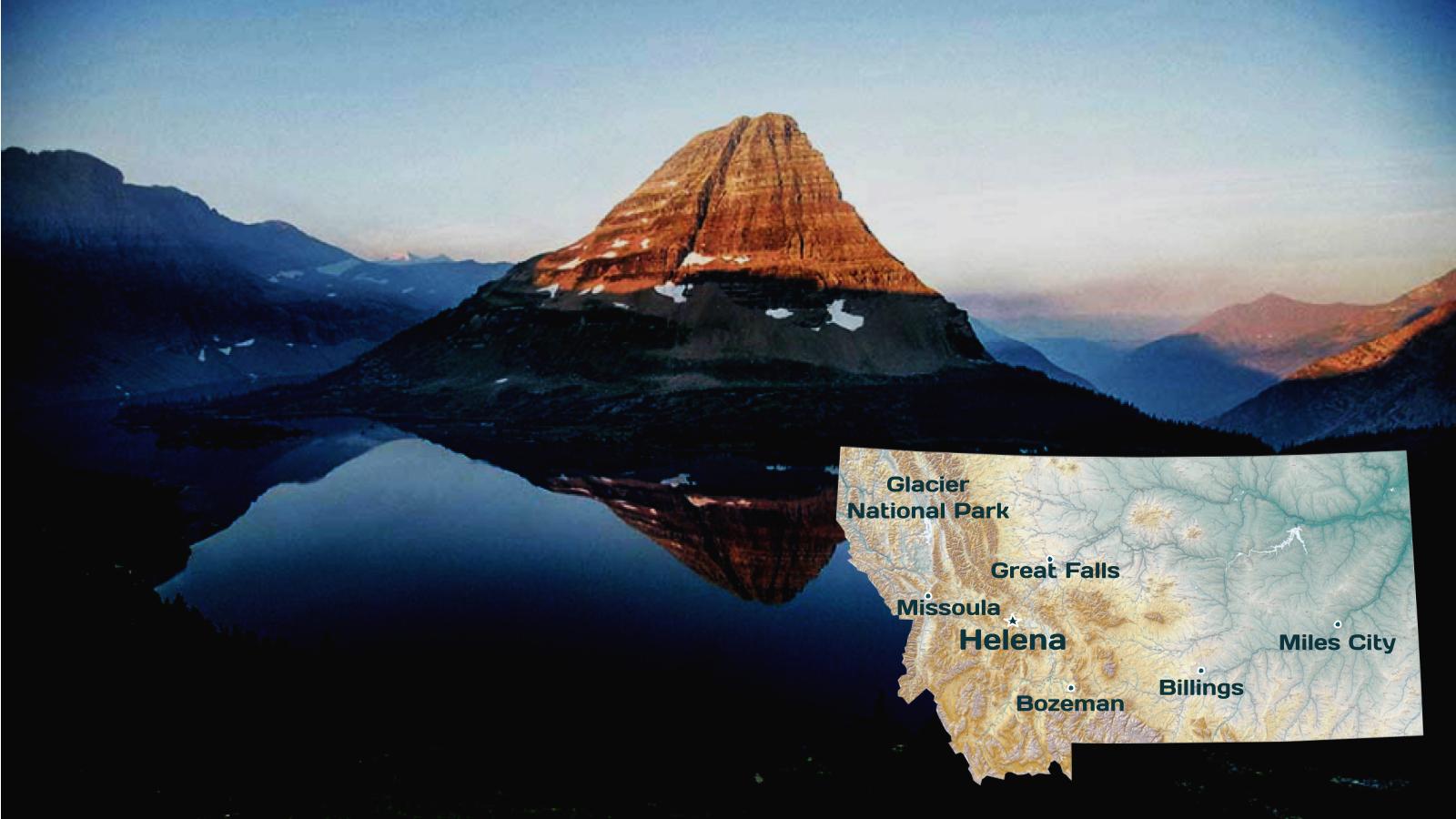Summary
The Montana onAir Hub supports Montanans to become more informed about and engaged in local, state, and federal politics while facilitating more civil and positive discussions with their representatives, candidates, and fellow citizens.
- Montana onAir is one of 50 state governance and elections hubs that the US onAir Network is providing to help reinvigorate US democracy. This post has short summaries of current state and federal representatives with links to their complete Hub posts. Students curate post content from government, campaign, social media, and public websites. Key content on the Montana Hub is also replicated on the US onAir nations Hub at: us.onair.cc.
- Montana will be forming onAir chapters in their colleges and universities to help curate Hub content. As more students participate and more onAir chapters are started, we will expand to include more state and local content as well as increase the number of aircasts – student-led, livestreamed, online discussions with candidates, representatives, and the public.
Find out more about Who Represents Me in Montana
Learn more about the US onAir Network
News
he base content in each post in this Montana onAir Hub has been updated as of 12/20/23. In addition to the eight posts on the home page, in depth posts on each US House member and posts on Montanag government and elections have been started. These posts have been shared with the US onAir Hub and will updated in the US onAir automatically when they are updated in this hub.
If your university or nonpartisan organization (such as a government focused research center, citizen engagement program or a League of Women Voters chapter) is interested in assisting the US onAir network to help curate new issue posts or other posts on this Hub and moderate the forums in each post, contact Ben Murphy at Ben.Murphy@onair.cc.
We are also supporting college students to start an onAir chapter on the their campus to coordinate the curation and moderation of posts especially on state and local representatives and government.
About
Web Links
State Representatives
Governor Greg Gianforte
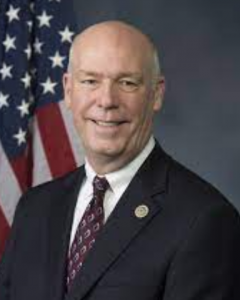 Current Position: Governor since 2021
Current Position: Governor since 2021
Affiliation: Republican
Former Position: US Representative from 2017 – 2021
In 1997, Gianforte and his wife, Susan, co-founded RightNow Technologies, a customer relationship management software company. The company went public in 2004; by that time, it employed over 1,000 workers. RightNow Technologies was acquired by Oracle Corporation for $1.5 billion in 2011.
Gianforte began his career in 1983 at Bell Laboratories, working in product acquisition. Gianforte then co-found Brightwork Development Inc., a developer of server-based LAN management software for the banking industry. He and his partners sold the company to McAfee Associates for $10 million in 1994. Gianforte then began working for McAfee as head of North American sales. In 1995, he moved to Bozeman, Montana.
Quotes:
Gianforte campaigned on getting Montana’s economy going again, getting Montana safely open for business, and getting Montanans back to work in good-paying jobs. He also focused on changing the way Helena and state government do business to better serve Montanans (from website).
Montana Governor Greg Gianforte Signs 3 Landmark Pro-Life Bills
OnAir Post: Greg Gianforte – MT
US Representatives
Senator Jon Tester
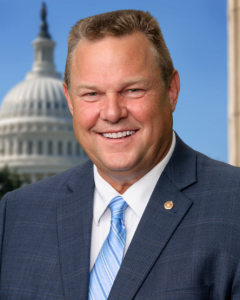 Current Position: US Senator since 2007
Current Position: US Senator since 2007
Affiliation: Democrat
Former Position: State Senator from 1996 – 2006
Other Positions: Chair, Defense Subcommittee -Appropriations Committee
In 1978, Tester graduated from the University of Providence with a B.A. in music. Tester worked for two years as a music teacher in the Big Sandy School District before returning to his family’s farm and custom butcher shop. He and his wife continue to operate the farm; in the 1980s, they switched from conventional to organic farming.
Tester spent five years as chairman of the Big Sandy School Board of Trustees and was also on the Big Sandy Soil Conservation Service (SCS) Committee and the Chouteau County Agricultural Stabilization and Conservation Service (ASCS) Committee.
Quotes:
Jon believes in holding himself accountable to the highest standards possible, and he has improved transparency at all levels of government. In fact, Jon was the first senator to post his daily public schedule online (from website).
OnAir Post: Jon Tester – MT
Senator Steve Daines
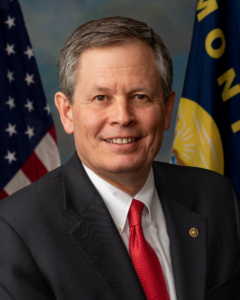 Current Position: US Senator since 2015
Current Position: US Senator since 2015
Affiliation: Republican
Former Position: US Representative for At-Large member from 2012 – 2020
Committees: Finance; Banking, Housing and Urban Affairs Committee; Energy and Natural Resources; Indian Affairs
Before entering politics, he held positions at Procter & Gamble and the Montana-based software service RightNow Technologies. He was Roy Brown’s running mate in the 2008 Montana gubernatorial election.
Quotes:
In the U.S. Senate, Daines is working on issues of critical importance to growing good-paying Montana jobs, developing our state’s energy resources, managing and protecting our public lands and supporting the needs of Montana’s veterans and tribes.
Steve Daines sounds the alarm on cartels bringing meth across southern border
OnAir Post: Steve Daines – MT
Ryan Zinke MT-01
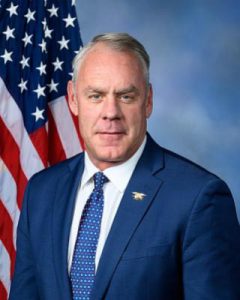 Current Position: US Representative of MT-01 since 2023
Current Position: US Representative of MT-01 since 2023
Affiliation: Republican
Former Positions: United States secretary of the interior under president Donald Trump 2017 to 2019
District: western third of the state
Upcoming Election:
Zinke served in the Montana Senate from 2009 to 2013 and as the U.S. representative for the at-large congressional district from 2015 to 2017. He served as the United States secretary of the interior under president Donald Trump from 2017 until his resignation in 2019 following a series of ethical scandals.
Zinke graduated from multiple colleges before he was a U.S. Navy SEAL from 1986 until 2008, retiring as a commander. In 2005, Zinke formed Continental Divide International, a property management and business development consulting company. His family members are officers of the company. In 2009, Zinke formed the consulting company On Point Montana.
OnAir Post: Ryan Zinke MT-01
Matt Rosendale MT-02
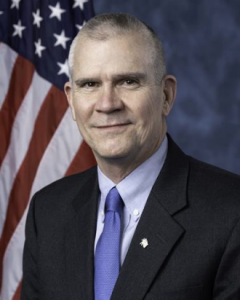 Current Position: US Representative of MT-02 since 2021
Current Position: US Representative of MT-02 since 2021
Affiliation: Republican
Former Positions: Montana State Auditor and Commissioner of Securities and Insurance. from 2017 – 2020; State Senator from 2011 – 2017
District: eastern portion of Montana, in a configuration similar to the 1983–1993 map. However, the state capital, Helena, which had historically been in the 1st district, was drawn into the 2nd district.
Upcoming Election:
Matt Rosendale served as Senate majority leader from 2015 to 2017. He was elected to represent Montana’s at-large congressional district in 2020. After Montana regained its second House seat in the 2020 census, Rosendale was elected to represent the new 2nd congressional district in 2022.
Rosendale worked in Maryland in the fields of real estate development and land management before moving with his family to Glendive, Montana in 2002. In Montana, he was twice elected chairman of the Glendive Agri-Trade Expo committee, a local group that puts on an agriculture exposition showcasing agri-business in eastern Montana.
OnAir Post: Matt Rosendale MT-02
More Information
Wikipedia
Contents

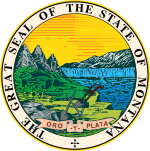
As established and defined by the Montana Constitution, the government of the State of Montana is composed of three branches, the Executive, Judicial, and Legislative. The powers of initiative and referendum are reserved for the citizens of Montana.
The second and current state constitution was enacted in 1972.[1] Among its changes, it stipulated that all Montanans’ access to their government is a constitutionally protected right, and it includes the right to examine documents or to observe the deliberations of all public bodies or agencies of state government and its subdivisions.[2]
Legislative Branch
Like the federal government and 48 other states, Montana has a bicameral legislature composed of two chambers, a 100-member House of Representatives and a 50-member Senate. Legislators are elected by popular vote. As of 1992 term limits were enacted limiting House members to four 2-year terms, and Senate members to two 4-year terms. The Montana State Legislature convenes only on odd-numbered years, and for 90-day periods. In addition, state law allows for the legislature to be convened in special session by the governor or at the written request of a majority of the members. As of 2005, the Montana Legislature has been convened in special session thirty times in its history.[3]
Executive branch
The daily administration of the state’s laws, as defined in the Montana Code Annotated, are carried out by the chief executive—the Governor, and their second in command the Lieutenant Governor, the Secretary Of State, the Attorney General, the Superintendent of Public Instruction, the State Auditor, and by the staff and employees of the 14 executive branch agencies.
Acknowledging the importance of providing for an orderly arrangement in the administrative organization of state government, the number of principal departments from which all executive and administrative offices, boards, bureaus, commissions, agencies and instrumentalities of the executive branch (except for the office of governor, lieutenant governor, secretary of state, attorney general, superintendent of public instruction, and auditor) must perform their respective functions, powers, and duties, is constitutionally limited to not more than 20 principal departments.[4] Currently the state operates with 14 principal departments. Provision is made within the state constitution for the establishment of temporary commissions not allocated within a department.
Executive branch agencies
| Department | Description |
|---|---|
| Administration | Provides general and administrative services in the areas of financial services, facilities management, public procurement, printing, mailing, surplus property management, architectural and engineering services, risk management and tort defense, personnel services, labor relations, information technology, and professional development. |
| Agriculture | Protects producers and consumers, enhances and develops agricultural and allied industries through its agricultural sciences and agricultural development divisions. |
| Commerce | Acts as an information broker for businesses and communities in the areas of economic and community development. Promotes Montana as a place to visit, to locate business, and to film motion pictures, commercials, documentaries, and features. |
| Corrections | Operates and administrates the state’s adult and juvenile correctional facilities including the Montana State Prison located in Deer Lodge and the Montana Women’s Prison located in Billings. Supervises probationers and parolees. |
| Environmental Quality | Protects, sustains, and improves a clean and healthful environment to benefit present and future generations. This is accomplished through managing, planning, and enforcing air and water quality laws and administrative rules. Remediation responsibilities include overseeing investigation and cleanup activities at state and federal Superfund sites to ensure compliance with applicable state and federal regulations, and to prevent exposure of potential human and ecological receptors to hazardous or toxic materials that have been released to soil, sediment, surface water, or groundwater. |
| Fish, Wildlife and Parks | Provides for the stewardship of the state’s fish, wildlife, parks and recreational resources through the management of state fisheries, parks and trails, and regulates state wildlife resources. Enforces state fish, wildlife, and parks laws, as well as boating, snowmobile, off-highway rules and regulations. |
| Labor and Industry | Regulates and manages workers’ compensation program, provides assistance to employers in filing quarterly wage reports and paying unemployment insurance tax, and administrates unemployment insurance claims for eligible unemployed workers. Upholds public policy as it relates to employment relationships and illegal discrimination. Through its workforce centers in cities across the state the agency provides job seekers and employers the resources and forums to maintain a high quality workforce. |
| Livestock | Primary mission is to control and eradicate animal diseases, prevent the transmission of animal diseases to humans, and to protect the livestock industry from theft and predatory animals. Conducts enforcement and investigative work in the tracking of livestock ownership and in the deterrence and/or solution of related criminal activities Also monitors and regulates the horse racing industry in the state. |
| Military Affairs | Oversees all activities of the Army and Air National Guard, Disaster and Emergency Services Division, and provides administrative support to the Veterans Affairs Division, which is administratively attached to the department. The department is administered by the Adjutant General and his staff. |
| Natural Resources and Conservation | Promotes stewardship of Montana’s water, soil, forest, and rangeland resources; regulates forest practices and oil and gas exploration and production, and administers several grant and loan programs. The Fire and Aviation Management program is responsible for protecting 50,000,000 acres (200,000 km2) of state and private forest and watershed lands from wildfire, while the Tree and Shrub Nursery program grows and sells seedlings for conservation and reforestation plantings on state and private lands. |
| Public Health and Human Services | The largest agency within state government, DPHHS administrates a wide range of public assistance programs including; Medicaid, Temporary Assistance for Needy Families (TANF), food stamps, special supplemental nutrition program for Women, Infants, and Children (WIC), Children’s Health Insurance Plan (CHIP), energy assistance, child care assistance. Other programs and services provided by the agency include; adoption services, services for the aging, child support, disability services, drug & alcohol addiction, mental health services and facilities. Oversees the coordination of the public health system in Montana through organized efforts to prevent, identify, and counter threats to the health of the public. Programs range in scope from nutrition support and Health Education, to screening services, to preventive services and surveillance systems for infectious and chronic diseases. |
| Revenue | The agency responsible for; overseeing revenue collection activity and audits, verifying compliance with state tax laws, and for the valuation and assessment of real and personal property for property tax purposes. The agency also administers the state’s Alcoholic Beverage Code, which governs the control, sale and distribution of alcoholic beverages. |
| Transportation | The agency responsible for transportation systems and services, including the state’s highway and rail systems, and air service. Primary responsibilities include; public transportation and rail programs and planning, general aviation airport planning, management of the state motor pool, maintenance of state highways, bridges and rest areas, motor fuel collection and enforcement, enforcement of vehicle weight and dimension laws and the Outdoor Advertising Control Act, and highway traffic safety. Duties include; planning and design activities, contract administration, materials design and testing, fiscal programming and cost accounting, and property acquisition. |
Commissions, Councils, Boards and Offices
Advisory Council on Aging | Information Technology Board |
Judicial Branch
The highest court in the state is the Montana Supreme Court. The court hears cases pertaining to the disputes involving Montana State Government, and interprets; state statutes, the State constitution, and administrative rules. Unlike most state court systems and the federal judiciary, Montana does not have an intermediate appellate court; the State Supreme Court must hear all appeals. The Montana Supreme Court has other duties, including lawyer discipline and revisions of various rules, such as the Montana Rules of Civil and Appellate Procedure, the Rules of Professional Conduct that apply to Montana lawyers, and the Rules of Lawyer Disciplinary Enforcement that govern lawyer discipline cases. On occasion, the Montana Supreme Court also must determine whether to impose judicial discipline as recommended by the Judicial Standards Commission. The Montana Water Court adjudicates matters of water rights within the state.
The Judicial power of the State of Montana is vested in the following:
- The Supreme Court, consisting of a Chief Justice and six Associate Justices
- The District Courts
- The Workers’ Compensation Court
- The Water Court
- The Courts of Limited Jurisdiction, which include Justice Courts, Municipal Courts, and City Courts.
See also
References
- ^ Montana’s Official State Website, http://mt.gov/discover/brief_history.asp “Brief History of Montana“
- ^ Montana Constitution Article II Section 9,“Montana Constitution, Article II, Section 9. Right to know”. Archived from the original on 2007-07-03. Retrieved 2007-07-09. “Right to know“
- ^ Montana State Legislature,“Special Sessions of the Montana Legislature”. Archived from the original on 2007-07-04. Retrieved 2007-07-09. “Special sessions of the Montana Legislature“
- ^ Montana Constitution Article VI Section 7.20,“Montana Constitution, Article VI, Section 7. 20 departments”. Archived from the original on 2007-03-14. Retrieved 2007-07-09. “Departments“
External links
Montana Code Annotated (MCA) [1]
Montana State Legislature [2]
State of Montana, Agency Listings [3]
